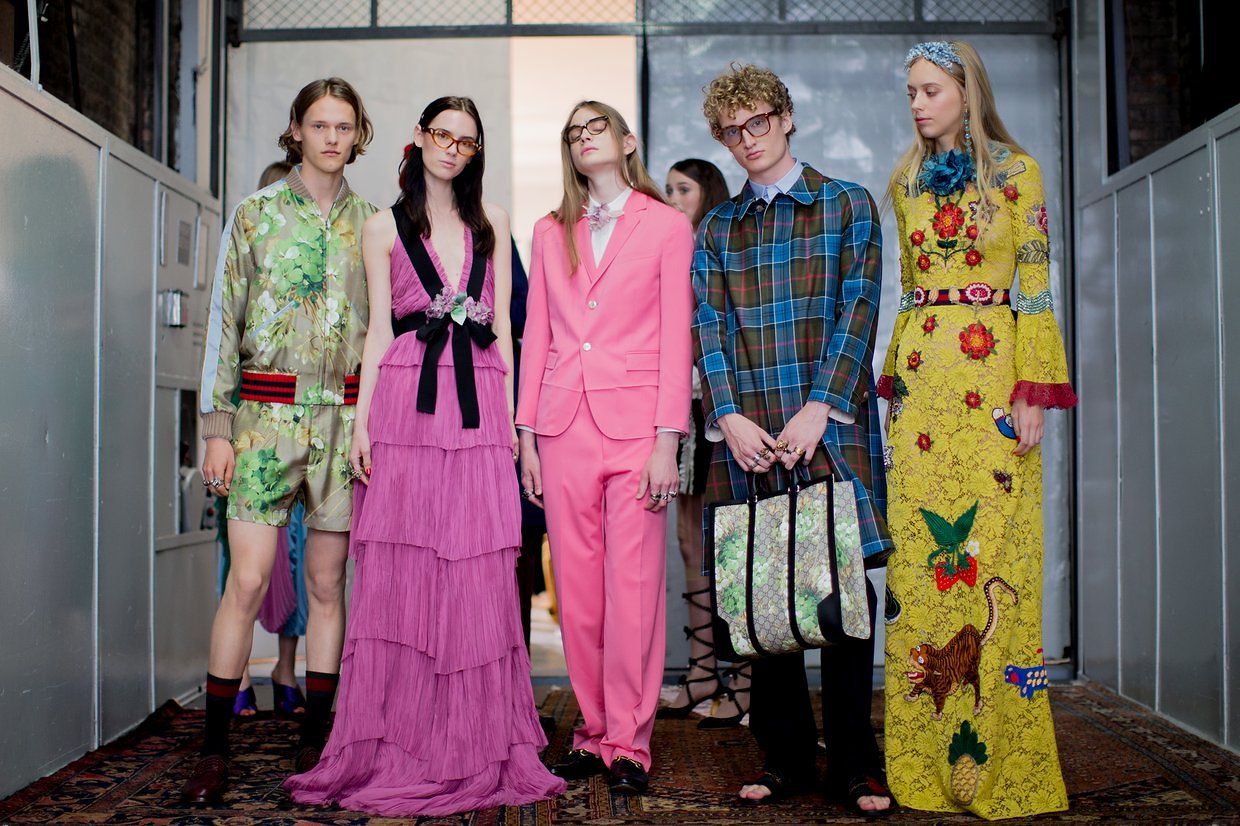
Episode V: The Nerds Strike Back

Gucci’s 2016 Cruise Lookbook highlights nerd fashion.
This past weekend, the 2016 Comic-Con International was held in San Diego, bringing with it an expected $150,000,000 and 130,000 attendees. The convention maxed out the convention center space and forced the convention to extend into local buildings to accommodate the growing attendance. The convention dominated the headlines of news sources with the announcement of upcoming films, astounding cosplays, and the appearances of movie stars. But this growing attendance and dominance of the headlines may be more symbolic of a shift in culture; nerd-dom seems to be becoming mainstream in popular culture.
The rising prevalence of nerd-dom (nerdy characteristics, culture, and fandoms) in mainstream culture can be seen in the soaring attendance numbers of traditionally nerdy conventions (not exclusive to the Comic-Con International in San Diego). In 2015, New York Comic Con had its highest attendance ever with 167,000 attendees after adding more banquet halls and convention centers to its space. The less popular Phoenix Comic Con also broke records this year with 106,096 attendees. In 2015, the gaming fair E3 managed to have 50,000 attendees for the first time in a decade and allowed fans in for the first time ever. Conventions and fairs concerning nerdy topics like video games, anime, and comics are quickly growing in popularity.
Likewise, films that focus on superheroes have become more popular and prosperous. In the past decade, both DC and Marvel have established their own Cinematic Universe franchises in order to produce comic-book films. Of the top 15 highest grossing superhero films, all of them were produced after 2007 with the exception of two; the highest grossing film, The Avengers (2012), made $623,357,910 in its lifetime gross. These films were also all based off superhero characters originally presented in comic books. Demonstrating the ability of superhero films to appeal to the masses, Iron Man (2008) and The Dark Knight (2008)’s monetary success led studios to invest in superhero films. Disney alone spent $4 billion in order to acquire Marvel in 2009. Superhero and comic book fans no longer have the stigma of being weird, socially awkward kids who can’t manage to get a date; fans are now some among the masses indulging in media about superheroes.
Furthermore, nerdy topics are overtaking film and television. Sci-fi and fantasy, genres previously associated with lonely geeks who played Dungeons & Dragons in their basement, have become some of the most popular genres. Game of Thrones, a medieval-fantasy television show filled with fire-breathing dragons and sword fights, has become the most successful HBO series of all time. The show attracts millions of viewers each week, won the 2015 Emmy award for best drama (a feat no fantasy show has ever achieved), and surpassed The Sopranos in popularity. Fraternities, a bastion of social status at American universities, have been hosting viewing parties for the show. In addition, The Hunger Games (2012), a film based upon the book of the same name, is a sci-fi drama set in a dystopian world. The film franchise is so popular that it has managed to influence social movements. In Thailand, protestors flashed three fingers in the air to show their opposition to their military rulers, which is a form of silent resistance in the film franchise. This three finger salute is now banned in the country. Even the Star Wars franchise has made a comeback, releasing the new film Star Wars: The Force Awakens (2015), breaking the record for highest-grossing domestic film in the United States. The success of the film is not solely the result of dedicated fans, however. Disney distribution president Dave Hollis stated, “The speed with which [all-time gross] records are falling is a testament to the audience broadening out. And you can’t do these kind of numbers without extraordinary repeat business. We know anecdotally people are seeing it three and four times. Everyone wants to be part of something that has become a cultural phenomenon.” Star Wars, considered one of the chief fandoms of nerds, has spread to become a popular franchise again in the mainstream media and no longer ordained to be the topic only those who were “unpopular” enjoyed.
Even gaming has seen shifts in popularity. Gamers face their own stigma: when one competitive gamer was asked, “Have you ever been criticized for gaming so much?,” he responded by saying, “part of why I play is to counteract criticism. The mere fact that you asked that question without questioning how I’d react implies that’s something I still need to do…I want the world to know — and accept — that stereotypes are not what they seem.” However, like other facets of nerd culture, gaming is received more warmly than previously. The recently released augmented-reality game Pokémon Go has become more popular than Tinder, Twitter, and Facebook on mobile devices, despite the fact that Pokémon is normally associated with annoying children and socially-awkward adults who never grew up. On the other hand, Rockstar’s Grand Theft Auto V is the fastest-selling entertainment product in history. In fact, the 2014 Nielsen 360 Gaming Report concluded that 64% of Americans play video games. Video games are hardly restricted to the stereotypical nerd, but have progressed into a major part of life and culture.
Yet, what really shows nerd culture’s movement into mainstream popularity is the adoption of “geek chic.” In 2015, Vogue, the renowned and distinguished fashion magazine, had an article that geek chic was the next fashion phenomenon. Blazers, knee-socks, thick glasses, plaid, and vests were the next big thing. Gucci designer Alessandro Michele stated that fashion would now represent geek fashion’s “ugly pretty.” Similarly, Daily Mail author Bianca London announced that “thick-framed nerd specs” were now a “must-have style.” The rise of geek chic, a fashion considered inherently ugly and uncool, cannot be attributed to anything but the rising popularity of nerd-dom and its movement into mainstream culture.
Famous fandom theorist Henry Jenkins has also noticed this shift in the popularity of traditionally nerdy topics. In an interview with Frank Rose, Jenkins commented that while he is surprised by how much nerd fandom has grown, he isn’t completely surprised. In his book, Spreadable Media: Creating Value and Meaning in a Networked Culture, Jenkins states, “If it doesn’t spread, it’s dead.”[1] In summary, if something does not continue to circulate, remain popular, and grow, it will ultimately die. For Jenkins, fandoms and nerd culture specialize in maintaining their respective fandoms. With the internet’s ability to link groups and foster discussion, the culture could only grow. Jenkins adds that industry is reliant on the spread of their product, particularly through fans. “The companies that will thrive over the long term in a ‘spreadable media’ landscape are those that listen to, care about, and ultimately aim to speak to the needs and wants of their audiences as crucially as they do their own business goals.”[1] The growth of nerd-dom was clearly inevitable.
Henry Jenkins is not the only theorist to notice how nerd culture has become mainstream. In her essay, “The Big Bang Theory: Nerds and Kidults,” Janice Shaw argues that there has undoubtedly been a rise in nerd culture as popular culture due to the developing lifestyle of millennials.[2] She cites the television show The Big Bang Theory as a great example of the popularity of nerd-dom. The Big Bang Theory is a popular show that involves four nerdy scientists contrasted with an aspiring, attractive actress who lives across from two of them. The stereotypical nerds of the show are obsessed with comics, fantasy, computer games, collectibles, and science. Shaw explains that “The Big Bang Theory is a television series that exploits the current movement to adopt an adolescent lifestyle of its target audience of millennial adults in their twenties and thirties.” She states, “The popularity of this program with the 18 to 34 year old demographic is indicative of the way it reflects the preoccupations of a generation characterized by a fascination with technological games and consumerism, a fascination that is also the basis of the popular conception of the nerd.” Shaw argues that like nerds, millennials struggle with commitment, social interactions (due to their dependence on technology), and “resist all the conventional actions associated with adulthood” like moving out, maintaining romantic relationships, and starting a family. The projection of nerd culture into the mainstream serves as a sort of relief and outlet for the new generation which opposes traditional adulthood and experiences little shame in embracing childlike media like My Little Pony and the tween text The Hunger Games. Another theorist, Kevin Kelly, agrees with Shaw on the development of nerd culture, or the “third culture” as he calls it. He states that nerd culture, “is not just an American phenomenon, either. The third culture is as international as science. As large numbers of the world’s population move into the global middle class, they share the ingredients needed for the third culture: science in schools; access to cheap hi-tech goods; media saturation; and most important, familiarity with other nerds and nerd culture.” For Shaw and Kelly, nerd culture and popular culture have merged.
While it may seem awesome to nerds everywhere that nerd culture is being embraced by popular culture, this rise in popularity provokes more questions and even the reconsideration of the definition of a nerd and nerd culture. Does the popularity of nerd-dom signify that the dedication of fans is more diluted because of its diversely invested fan base? Can nerd-dom be popular if nerds are to be defined as fanatical subsets of the population? What does it mean if all of the “outsiders” of nerd culture are really “insiders?” If nerdy subjects are those that are unpopular and nerd-dom has become popular, are they still stereotypically nerdy? Can nerds even still exist? In the attempts to reclaim nerd-dom, the meaning of what it means to be a nerd will be a new matter to grapple with.
_______________________________________________________________
- Jenkins, Henry, Ford, Sam and Green, Joshua. Spreadable Media: Creating Value and Meaning in a Networked Culture. New York: New York UP, 2013.
- Shaw, Janice. “The Big Bang Theory: Nerds and Kidults.” Millennials on Film and Television: Essays on the Politics of Popular Culture. By Betty Kaklamanidou and Margaret Tally. McFarland, 2014. 78-93.
Comments are closed, but trackbacks and pingbacks are open.